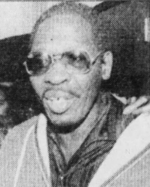 AP LaserPhoto In Elizabeth, New Jersey, a man kidnapped 21-year-old Joanne K. Nagan as she exited her car on October 19, 1974. The kidnapper took her to a housing project in Newark and raped her. She was then freed and was able to flag down a police officer. In a police lineup four months after the crime, Nagan identified Nathaniel Walker, a 33-year-old black factory worker, as her attacker. Walker had been serving time at Rahway State Prison for possession of stolen vehicles and was out of jail on a temporary leave at the time of the crime. He was arrested on February 10, 1975 and maintained that he had been at home with his wife Sharon when the crime occurred. At Walker’s trial in Union County Superior Court in May 1976, his wife was not called to testify although she was the only person who could have confirmed his alibi, and the prosecutor made note of this to the jury. After a three-hour long trial, the jury found Walker guilty on charges of kidnapping, rape, and sodomy. He was sentenced to life plus 43 to 50 years in prison. The appellate court reversed his conviction in 1977 because the court found the prosecutor had erred in commenting on the absence of testimony from Walker’s wife. Following the reversal, Walker was released on bail. On June 7, 1979, the Supreme Court of New Jersey reinstated Walker’s conviction on the basis that Walker had waived his marital privilege and the prosecutor had not erred in the trial. Shortly before this time, famed defense attorney and civil rights activist William M. Kunstler joined Walker’s defense. Kunstler planned to appeal Walker’s conviction on several grounds, including the original defense attorney having erred by not calling Walker’s wife to testify. According to court papers filed by Kunstler, Nagan had initially told police that her attacker had one testicle, was circumcised, and was not wearing glasses, whereas Walker had two testicles, was not circumcised, and was legally blind without his glasses. Kunstler also filed a writ of habeas corpus in federal court stating that Walker’s trial judge was racist and Walker’s constitutional rights had been violated. U.S. District Court Judge Frederick B. Lacey denied this habeas corpus petition on June 12, 1979, at which point Walker was required to return to prison. However, rather than returning to prison, Walker fled the state, resulting in his name being added to New Jersey’s “12 Most Wanted” list. He lived as a fugitive until 1982, at which time he was located in Los Angeles, where he had been living and working under an assumed name. He was arrested and extradited back to New Jersey. After Walker’s return to prison, he connected with the prisoner advocacy group Centurion Ministries, which focused on cases of the wrongly convicted. Centurion Ministries began reviewing all the details of Walker’s case in collaboration with Walker’s defense attorney Paul Casteleiro. In doing so, Centurion Ministries and Casteleiro found that there was an untested sperm sample from the crime scene that was still sitting at the Elizabeth police station. In 1986, this neglected semen sample from the crime was tested by the FBI and compared with Walker’s blood sample. Based on the blood antigens in the semen sample, Walker was ruled out as the possible source of the semen. Walker’s conviction was overturned and the charges against him were dismissed. He was released from prison on November 5, 1986. At the time of Walker’s release, New Jersey had not yet adopted a statute to compensate the wrongfully convicted and Walker did not have a civil rights claim against the police. To collect damages for his wrongful conviction, Walker’s only option was to sue his attorneys who had failed to order the serological testing when they represented him in the 1970’s. Walker filed a lawsuit against these attorneys, which was eventually settled for $250,000. – Meghan Barrett Cousino
|